Social Stigma in the Community under the Recurring Crisis of COVID 19 Maha Sarakham Province
Keywords:
Empowerment, Health, Village Public HealthAbstract
This research consists purposes were to studied the social stigma in the community of Mahasarakham province under the recurring crisis of COVID-19. This research was qualitative research There is a research tool which is the Interview and Group Discussion. The Purposive Sampling was divided into 3 groups: Individuals who have previously contracted COVID-19, Individuals residing in the same household as those infected with COVID-19 and Community leaders. The sample size consists of 20 data points. The information gathered from interview forms and related documents were then content analysis. This research found that the social stigma consists of 3 patterns as follows: 1) The self-stigmatization among the group of patients reveals high levels of stress, loneliness, isolation, and extreme anxiety due to the lack of treatment and preventive vaccines for COVID-19. They fear being carriers of the virus and transmitting it to family members. Additionally, they perceive themselves as a financial and caregiving burden during the quarantine period. Moreover, they are apprehensive about facing community ostracism and being expelled from the area due to fears of being the source of disease transmission. 2) Personal Stigma feel burdened by financial costs, caregiving responsibilities, and reporting requirements. This burden often leads to the concealment of information to alleviate these challenges. 3) Public Stigma has intensified due to a collective lack of knowledge about COVID-19, as it is a newly emerged disease. Additionally, the dissemination of various information through online media has led to conflicts within the community. When people feel afraid of the unknown, they tend to easily project their fear onto others. The impacts resulting from social stigma are significant and can be categorized into three levels: 1) Impact on physical and mental health: Stigmatization affects the overall well-being of individuals, both physically and mentally. 2) Impact on family duties and increased burden: Stigmatization adds to the responsibilities and burdens placed on families. 3) Impact on the community: Community stigma contributes to the perception of individuals as dangerous, leading to conflicts within the community.


